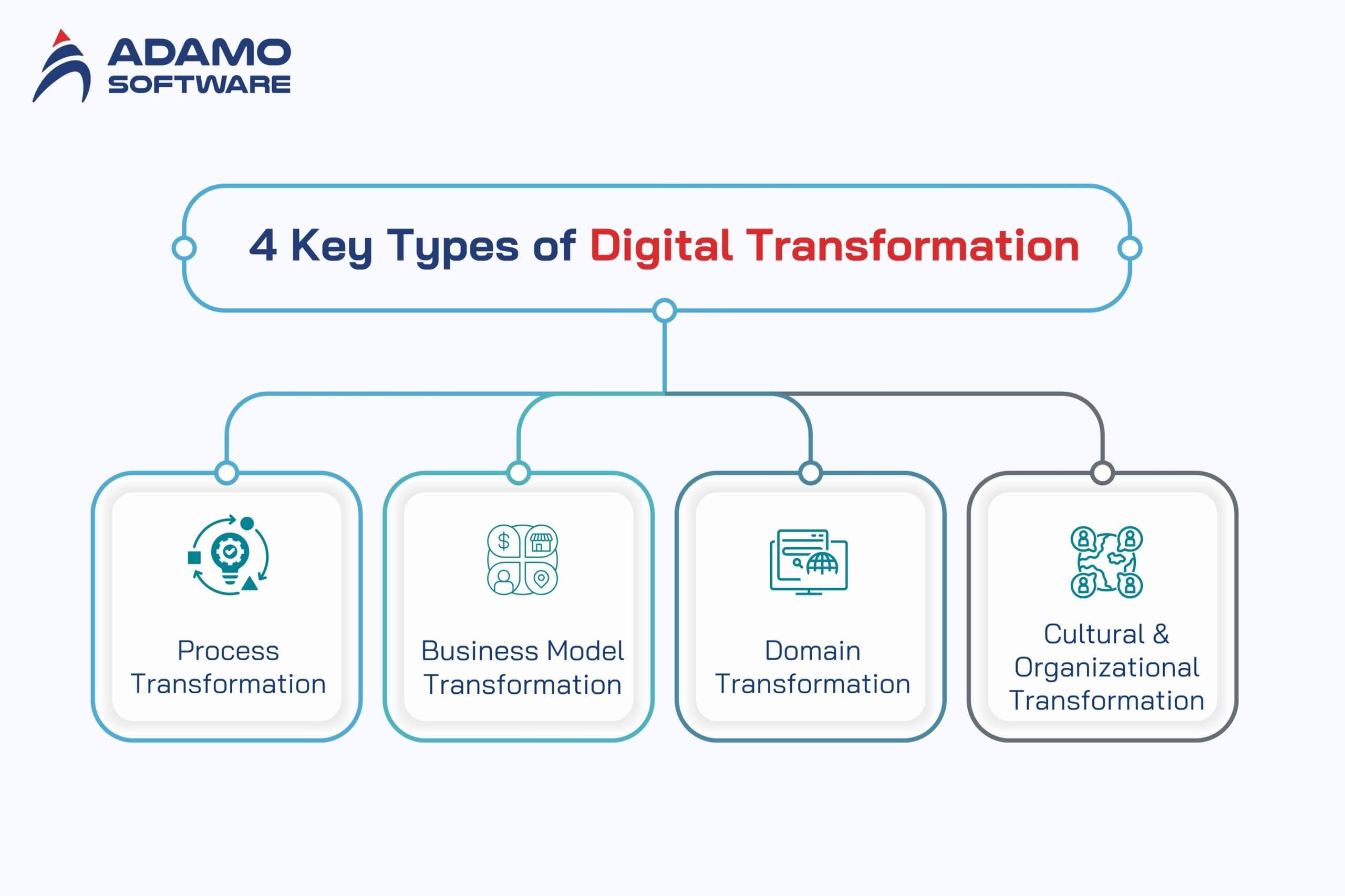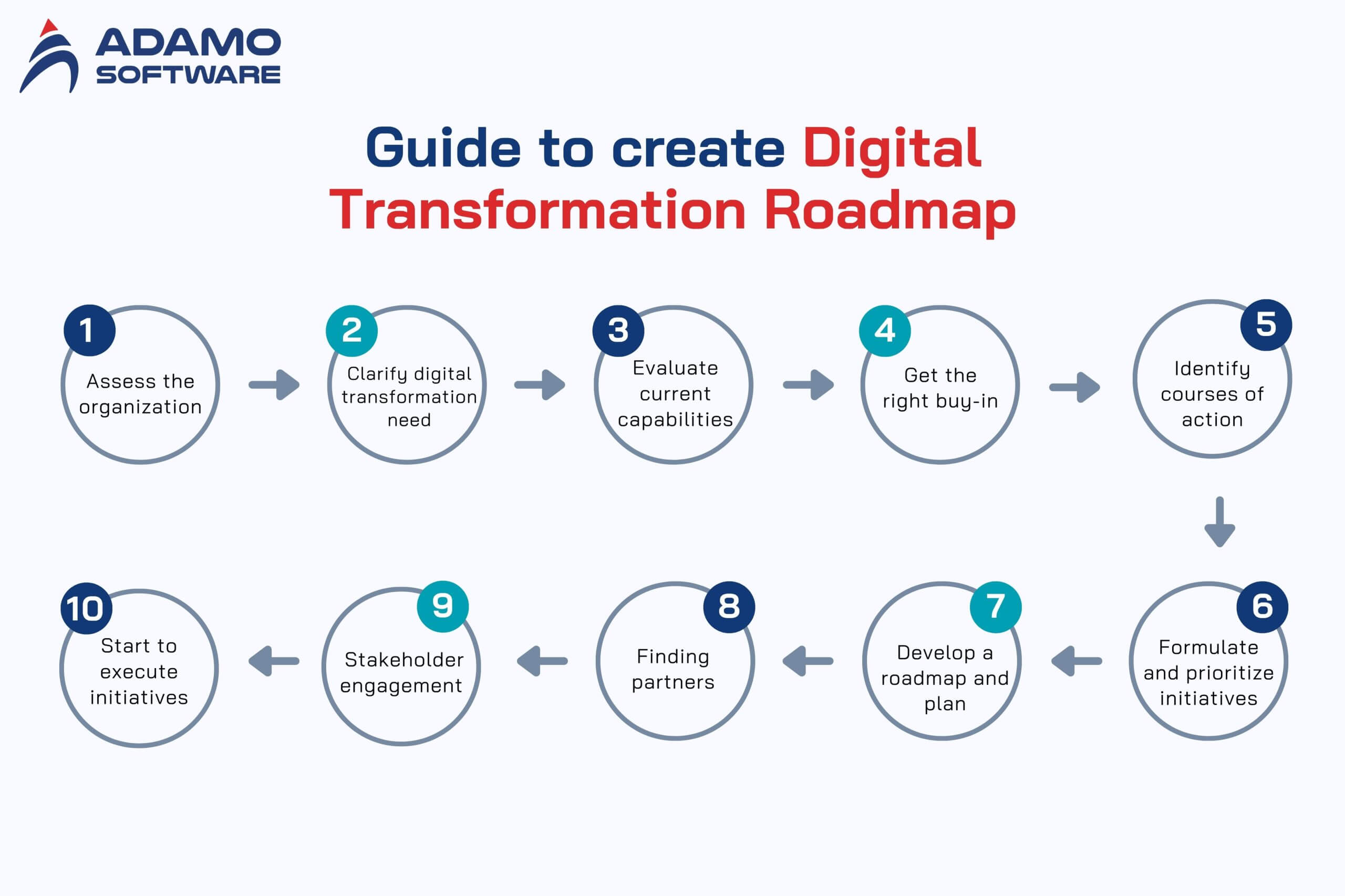Digital Transformation Roadmap: Key types and actionable steps

In today’s digital world, each business must have a digital transformation roadmap. Let’s learn about this with Adamo Software!
In today’s business world, digital transformation has become an indispensable part, creating a significant change in the way businesses access and execute business processes. However, this is not an easy task. Besides understanding what digital transformation is, businesses may want to know how to implement a successful process with a clear roadmap. Let’s learn about the digital transformation roadmap with Adamo Software!
Through this blog post, you will find the following pieces of information.
- What Is a Digital Transformation Roadmap?
- 4 Key Types of Digital Transformation
- Step-by-step guide to create a Digital Transformation Roadmap
All information has been thoroughly researched and updated to the latest trends by Adamo Software. So, let’s read our blog post and find some useful information!
I. What Is a Digital Transformation Roadmap?
Before learning about a digital transformation roadmap, it is essential to understand digital transformation itself. Digital transformation refers to any technological innovation that a business can apply to enhance business efficiency. The digital transformation innovation can be categorized into many forms and levels. A business can utilize cloud storage software to reduce manual paperwork and automate repetitive processes.
Your digital transformation needs a comprehensive plan for a smooth and effective shift. This is called a digital transformation roadmap. It is a structured plan that links your digital strategy and new technology to your business goals. This facilitates a seamless transition to more efficient, data-driven, and automated processes.
The digital transformation roadmap helps businesses identify new technology, updated processes, prioritize what to tackle first, track progress, and ensure resources are used effectively. Your business strategy will affect your digital transformation roadmap. You may want to think of the following questions for a comprehensive transformation.
- Which problems can digital transformation deal with?
- How will your business change when implementing digital transformation?
- What resources and capabilities will you need for digital transformation?
- In what ways will you check your progress on your digital transformation roadmap?
With a clear digital transformation roadmap, businesses gain transparency, build consensus, and adopt a systematic approach to implementing their transformation. Without a clear roadmap, digital initiatives can easily become disorganized, resource-intensive, and ineffective. Let’s keep reading for some types of digital transformation!
II. 4 Key Types of Digital Transformation
To build an effective digital transformation roadmap, you may want to thoroughly understand digital transformation types. While they collaborate to achieve a complete transformation, they focus on a different segment of the organization. Below are four key types of digital transformation.

- Process Transformation: Aiming to streamline operations
- Business Model Transformation: Working to innovate business models
- Domain Transformation: Expanding market reach
- Cultural and Organizational Transformation: Building an adaptive, resilient organization
Let’s delve into each type with Adamo Software!
1. Process Transformation
In the digital transformation roadmap, the process transformation plays an important role in enhancing business performance. This type of digital transformation focuses on optimizing internal processes to increase efficiency, reduce costs, and improve productivity.
Process transformation’s main goal is to make operations faster and more accurate while minimizing manual intervention. It supports businesses in building a more flexible and modern operating platform. This digital transformation type may involve using Robotic Process Automation (RPA) for task automation, AI for predictive maintenance, and data analytics for inventory optimization.
2. Business Model Transformation
Business model transformation is also an indispensable type in the digital transformation roadmap. This type’s focus is on changing the way businesses provide value, sell products, and make revenues, thereby better adapting to the digital market.
The goal of this digital transformation type is to explore and implement new ways of making money, helping businesses stay competitive in the market. Besides, it also contributes to reshaping the customer experience journey, from product access to payment methods and service usage, aligning with modern consumer trends in the digital transformation roadmap.
For example, Adobe adopted this type of digital transformation by changing from selling software as a one-time purchase to a subscription model that allows users to use their software on a monthly or yearly basis. Similarly, Netflix also transformed from a DVD rental service into an exclusive digital streaming platform, completely changing how users access and consume entertainment.
Also read:
Digital Transformation Examples: Top 10 real-world success
Digital Transformation Services Companies: The Best Partners for Your Next Big Move
Explore Our Tailor-made Software Development Solutions
We are confident in providing end-to-end software development services from fully-functioned prototype to design, MVP development and deployment.
3. Domain Transformation
Domain transformation in the digital transformation roadmap helps businesses expand into new industries or markets through digital tools and technologies. The process emphasizes internal enhancements and reshaping the business scope to unlock new growth potential. The goal of domain transformation is to diversify income and expand market reach.
One of the outstanding examples of businesses successfully adopting this digital transformation type is Amazon. This company has expanded beyond online retail to cloud computing with its AWS service, which is now one of the company’s biggest sources of revenue. Google, too, moved past search and digital advertising, venturing into self-driving car technology via its Waymo project.
4. Cultural and Organizational Transformation
Cultural and organizational transformation helps businesses maintain flexibility and adaptability to constant technological change. The focus of this phase is to build a work environment that promotes innovation, collaboration, and flexible working methods.
The ultimate goal of this digital transformation type is to build an organization that is adaptable, resilient to change, and ready to grow with technology. This is an irreplaceable element in the digital transformation roadmap, ensuring the sustainability and long-term success of the digital transformation process.
To adopt this digital transformation type, you can encourage cross-departmental collaboration, adopt Agile project management methods, promote data-driven decision making, and invest in digital skills training for employees. These factors boost efficiency and foster continuous innovation.
Overall, these types of digital transformations empower businesses to embrace digital change, boosting their operations and improving customer experiences. Additionally, they reveal new avenues for growth.
III. Step-by-step guide to create Digital Transformation Roadmap
The digital transformation roadmap divides businesses’ digital transformation tasks into smaller steps, which align every effort with the overall strategy. Below are ten essential steps to create a digital transformation roadmap.

- Assessing the organization: Assessment of capacity and readiness
- Clarifying why you need digital transformation: Business and digital strategy connection
- Evaluating current capabilities: Requirements identification
- Getting the right buy-in: Key to starting and investing in digital
- Identifying courses of action: Future capabilities identification
- Formulating and prioritizing initiatives: Idea grouping and evaluating
- Developing a roadmap and plan: Determining the sequence and delivery schedule
- Finding partners to support implementation
- Communication and stakeholder engagement: Communicating to build consensus
- Starting to execute initiatives: Actual assessment, approval, and implementation
Let’s discuss each step with Adamo Software!
1. Assessing the organization
The first step in creating a digital transformation roadmap is to assess the organization. This involves organizational structure, human resources, operating processes, and organizational culture. The aim of this step is to identify the business’s readiness for digital transformation and current challenges in transforming. Below are some activities to note in this step.
- Assessing organizational structure and internal process
You may need to assess your organizational structure, internal processes, and operational system flexibility. This allows you to detect potential challenges in implementing the digital transformation roadmap.
- Identifying challenges
Identifying challenges is also an essential responsibility. Let’s compare the current state with the desired transformation goals to identify gaps that need to be filled. Challenges may come from outdated processes, a lack of digital skills, fragmented data, or a lack of alignment between departments.
- Assessing the level of readiness for transformation
When you assess an organization in developing a digital transformation roadmap, you should also consider the level of readiness for transformation. This helps determine if additional preparation steps, such as skills training, awareness raising, or strategic adjustments, are needed.
2. Clarifying why you need digital transformation
After you have assessed your organization, you may want to clarify why you need digital transformation. This is an essential step in creating a digital transformation roadmap that ensures future activities have clear goals and are consistent with the overall development direction. Without identifying the right drivers, the transformation process can easily go off track or lack internal support.
You may want to clearly define the goals you want to achieve, such as enhancing customer experience, optimizing costs, expanding the market, etc. Answering the why question helps ensure that investments are directed in the right direction and deliver real value.
Additionally, clearly defining the reason for change helps build consensus internally and among stakeholders. When people understand why the organization needs to change, they are more willing to support and accompany the process.
3. Evaluating current capabilities
Evaluating current capabilities is also an indispensable step in creating a digital transformation roadmap. This requires you to know your internal abilities in terms of technology, people, processes, and data. Through this assessment, you can identify strengths and highlight gaps that need to be improved to prepare for the next steps.
Digital competency survey is an ideal tool for a comprehensive assessment, which measures the level of technological proficiency of each department and individual within the organization. Questions typically revolve around the use of digital tools, the level of automation, data analytics capabilities, and technology-based decision-making habits. From the survey results and overall assessment, businesses can make decisions about investing more in technology, replacing outdated systems, or building digital skills training programs for employees.
4. Getting the right buy-in
The next step in creating a digital transformation road is getting the right buy-in. This is not only the consensus, but it is also about commitment from management, employees, and strategic partners. All initiatives are difficult to implement successfully without this support.
To gather leadership team buy-in, you must identify who has influence and is willing to lead the digital transformation initiative. Besides, it is essential to clearly articulate the reasons for the transformation, the problems to be solved, and the opportunities to bring value to the organization. At the same time, let’s anticipate potential barriers, identify leadership concerns, and develop an appropriate persuasive strategy.
5. Identifying courses of action
Once you have consensus from stakeholders, you must identify courses of action in your digital transformation roadmap. This step defines what you must do, from improving processes, adopting new technologies, to changing the way we approach customers or our business model.
These actions must consider people, processes, and technology. A “people” course of action could be to appoint a dedicated fundraising support person; a “process” course of action, to enhance the donation process for online opportunities; and a “platform/technology” course of action, to implement a donor management system.
6. Formulating and prioritizing initiatives
The next step in your digital transformation roadmap creation is to formulate and prioritize your initiatives, projects, or programs. These initiatives could be external, like changes to products, services, or client experiences, or internal, such as cloud and technology infrastructure improvements. You can also combine these two initiatives.
Each digital initiative will vary in scope, resources, and return-on-investment. You may want to prioritize them based on their impact and estimated effort. Let’s begin with simple projects that have essential features to test your digital solution’s viability.
7. Developing a roadmap and plan
Developing a roadmap and plan is your next step in creating your digital transformation roadmap. This stage involves sequencing and scheduling delivery.
As you cannot tackle everything at once, you may want to ensure initiatives are well-resourced. Let’s build a team with the right skills and mindset to put your strategy into action.
Your digital transformation roadmap should include a realistic schedule and timeline for each initiative, based on priorities, duration, and available resources. Most digital transformations fail due to insufficient budget. Thus, when planning your budget, you must anticipate delays and obsolescence from new technology. Let’s conduct thorough pricing research and provide realistic cost estimates for every project on the roadmap.
8. Finding partners to support implementation
Your digital transformation roadmap cannot miss finding reliable partners. To reduce the burden on your internal team, you may want to use external resources like volunteers, consultants, or service providers.
You can engage as volunteers for smaller tech projects, but bigger ones will likely necessitate working with consultants. They guide the organization throughout the digital transformation, lending their experience to ensure sound decision-making. These partners can add value across strategy, services, technology, change management, and training.
9. Communication and stakeholder engagement
Keeping staff informed will motivate them to support the digital transformation roadmap. When people understand what’s happening and why, they’re more likely to embrace the changes. Inadequate communication of transformation benefits can result in low staff buy-in, potentially hindering later progress. Your communication and stakeholder plan should define your message and intended recipients, from internal staff to external sponsors. Besides, you should also determine the most effective channels, frequency, and communication tone.
10. Started executing initiatives
After finishing the above steps in creating a digital transformation roadmap, it’s time for you to start executing initiatives. This is the stage where plans are turned into concrete actions, ensuring that approved initiatives are implemented on schedule, on target, and delivering the expected value. As a final step, let’s learn why digital transformation projects fail and the key success factors. This turns your digital transformation roadmap’s idea into reality.
IV. Summary

In conclusion, a digital transformation roadmap is a plan that helps your business direct, implement, and measure digital initiatives to achieve long-term goals. Four types of digital transformation roadmaps include process transformation, business model transformation, domain transformation, and cultural and organizational transformation.
Each step in creating a digital transformation roadmap plays a fundamental role in ensuring that digital transformation is oriented and sustainable. When designed and executed properly, this roadmap will help you improve your business’s competitiveness in the digital age.
To successfully implement your digital transformation roadmap, you may want to coordinate with a reliable partner. As one of Vietnam’s leading technology companies, Adamo Software can be your ideal choice. Here’s how we can help.
- Assessing your capabilities and digital readiness
- Consulting on digital strategy linked to business goals
- Developing and implementing digital initiatives
- Analyzing ROI, assessing risk, and identifying priority initiatives
- Providing 24/7 post-implementation support
Still hesitating whether to choose Adamo Software? Let’s contact us for more detailed information.











